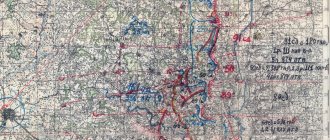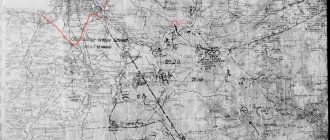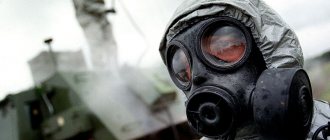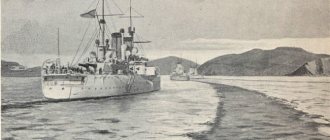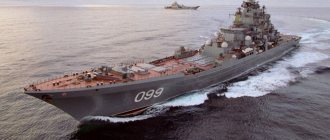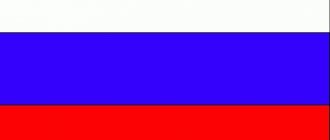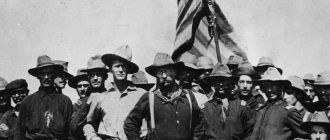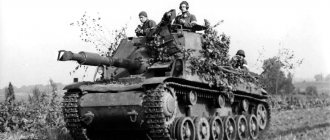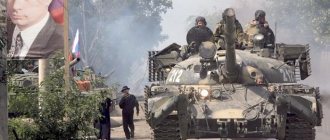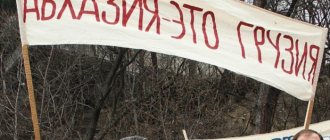The Russian military operation, taking place from 08/08/2008 to 08/12/2008, was called the “Five-Day War”. This operation was of a peacekeeping nature and was a response to Georgian aggression towards South Ossetia. This military operation was the first in the history of the Russian Federation to take place outside its territory.
The war in South Ossetia began on the night of August 7–8. That night, Georgian artillery struck Tskhinvali with a powerful blow, marking the beginning of the Russian-Georgian conflict. Immediately after the unprovoked artillery strike by Georgia, Russian troops located on the border and territory of South Ossetia began active operations that lasted for 5 days.
Increasing conflict in early 2008
The conflict between Georgia and South Ossetia has been escalating since the late 1980s. The first bloody battles between Georgia and the self-proclaimed republic of South Ossetia took place back in 1991-1992. Then Georgia imposed a complete economic blockade of South Ossetia, which led to the mass death of children and elderly people in the winter months. As a result of this conflict, a huge number of refugees tried to get into Russian territory, often being attacked by the Georgian military along the way.
In 2004, the conflict between Georgia and South Ossetia escalated again. The Georgian side began a large-scale campaign to restore the integrity of the country, considering the territory of South Ossetia to be its original territory. In 2004, Georgian troops were introduced into the territory of South Ossetia, and subsequently the systematic bombing of Ossetian cities and villages began. Only Russian intervention saved the young republic from the seizure of its territory by Georgia. At the same time, this strained Russian-Georgian relations.
In 2008, when tensions in the South Ossetian region reached the limit, Russia lifted the flank quota restrictions on the deployment of military forces in the North Caucasus. Already in April 2008, some units of the 7th Airborne Division were introduced into the territory of Abkhazia and located near the Georgian border.
At the end of May 2008, Russian railway troops, totaling about 400 people, entered Abkhaz territory. This deployment of troops caused real hysteria among the Georgian authorities, who declared to the whole world that Russia was preparing for a full-scale invasion of Georgian territory, under the guise of providing assistance to South Ossetia.
The second half of July was marked by joint exercises between the United States and Georgia, at which, according to military experts, the attack and seizure of the territory of South Ossetia was practiced. At the same time, Russia conducted the Caucasus-2008 exercises, in which units of various military and security forces took part. In addition to the exercises, Russian railway troops completely restored the railway tracks on the territory of Abkhazia.
The beginning of the confrontation between Georgia and South Ossetia
At the end of 1988, nationalist organizations became more active in the Georgian SSR, the main goal of which was the sovereignty of the region. Similar processes took place in the South Ossetian Autonomous Region - in November 1989 it was transformed into an autonomous republic within Georgia for the subsequent acquisition of the status of an independent state. Over the next two years, the Georgian and Ossetian sides created the legal and political basis for the implementation of sovereign plans.
On January 6, 1991, Georgian military columns entered the city of Tskhinvali in South Ossetia - this was the beginning of the protracted Georgian-Ossetian conflict. In June 1992, a quadripartite agreement was signed in Sochi with the participation of Russia, North Ossetia and the OSCE, designed to regulate what is happening in the region on the basis of international law. In accordance with the agreement, peacekeepers were brought into the region - representatives of the Russian, Georgian and Ossetian sides. They were supposed to guarantee security in the region and ensure control over the ceasefire and the withdrawal of armed forces.
However, the interests of the parties to this conflict were too different and there was little hope for a peaceful resolution. Georgia did not recognize the autonomy of South Ossetia, and the existence of an independent state of the same name was out of the question. On the other hand, South Ossetia held legitimate elections and a referendum, in which 98% of the population voted for independence, and formed its own political and administrative system.
The change of power in Georgia was important in the growing tension - during the “War of the Roses” at the end of 2003, E. Shevardnadze, who was committed to a peaceful solution to the problem, resigned. He was replaced by M. Saakashvili, confident in NATO support and determined to send troops if necessary.
While Georgia was strengthening its army with American money, South Ossetia found itself in a large-scale economic, information and transport blockade. In response, Russia economically and politically supported the leadership of Abkhazia and South Ossetia, and a significant part of their citizens were issued Russian passports.
Exacerbation of the military conflict in the Georgian-Ossetian region at the end of the summer of 2008
Starting from the end of July, various shootouts and raids began to systematically occur on the territory of South Ossetia, which the Georgian government diligently denied. As a result of instability, civilians quickly began to leave the region. Since the final target of all the raids was the city of Tskhinvali, the Prime Minister of South Ossetia Yuri Morozov signed documents on the mass evacuation of residents of this city.
In early August 2008, the concentration of military forces of the Georgian army on the border with South Ossetia reached a critical limit. Although both Georgia and Russia deny the presence of their regular troops on the territory of South Ossetia before the conflict began, some events indicate that both Georgian and Russian special forces military units were already in South Ossetia. The death of some contract soldiers from both sides on the first day of the conflict (August 8) indirectly testifies to this.
War and Peace
The Georgian army's attack on South Ossetia was not the result of unforeseen impulsiveness of Georgian President Saakashvili, as many subsequently tried to present. The reasons are deeper and the main goal was to level out Russia’s military-political influence in the region. It is clear that these plans did not come from Tbilisi.
The Georgian state was seriously preparing for war. Both morally and in terms of training the armed forces. Joint military exercises from the United States and Georgia have become commonplace. A variety of military equipment was supplied to the country, including its latest models. The training of combat operations in the proposed theater of military operations took place during joint exercises with units of NATO countries. They continued until the aggression began. Thus, in July 2008, the Georgian army, together with the American military, conducted the “Immediate Response” exercise.
Providing political cover for future aggression was also important. After the end of hostilities, the leaders of Georgia's Western allies denied that they had somehow motivated Saakashvili to commit aggression. But even if there was no official instruction, by their indulgence in Saakashvili’s revanchist rhetoric, the United States and Europe gave him carte blanche to act. Moreover, Russia’s American partners tried to lull Moscow’s vigilance. According to the same Sergei Ivanov, until 2008, Russia’s Western partners repeatedly promised that they would not allow a conflict. In particular, former US Secretary of State Condoleezza Rice .
“They told us and reassured us that Saakashvili would never decide on a military adventure. I can now openly admit that Condoleezza Rice, as US Secretary of State, kept telling me in private conversations: “Sergei, don’t worry, he won’t cross the red line,” he said.
However, Saakashvili crossed his rubicon, in the hope that the principle would work: “Winners are not judged.” But the Russian tanks, as he naively believed, did not turn out to be scrap metal.
Russia's reaction to the attack by the Georgian army on South Ossetia and Russian peacekeepers turned out to be a shock to the West. And it is no coincidence that American diplomacy responded to the events in South Ossetia immediately. Quite quickly, two circumstances became clear to the West. First, Russia was ready to take any steps to protect its citizens in South Ossetia and force Georgia to peace. Secondly, the West did not have any acceptable ways to counteract it. There is authoritative evidence that options for armed counteraction to Russia were discussed in Washington, and they were rejected: the United States chose to avoid war with a nuclear power.
The West's response to the war was largely limited to soft power. The United States sent warships with humanitarian cargo to Georgia. Western media broadcast an extremely one-sided version of events. American diplomats started talking about “isolating” Russia.
Diplomatic pressure did not deter Russia from recognizing the independence of Abkhazia and South Ossetia. However, Moscow had no other options after Georgia rejected an international discussion of the status of the two republics. But this pressure has once again convinced Russia that it is impossible to trust the West and that it is even difficult to count on understanding on its part.
Who started this conflict, the opinions of the warring parties
To this day, the conflicting parties blame each other for starting this conflict. To figure out who is really to blame, you need to hear all sides of the conflict and draw conclusions from this:
- The opinion of the Georgian government is unequivocal and unshakable. They claim that this conflict was started by the South Ossetian side, which entered into a conspiracy with Russia and carried out a series of provocations. According to Georgia, their invasion of the territory of South Ossetia was due to the fact that the Georgian military managed to intercept a secret telephone conversation in which information “came up” that Russian troops had already invaded the territory of South Ossetia on August 7;
- Russia's position on this issue was clearly voiced by Russian Foreign Minister Sergei Lavrov. He stated that the only reason for the entry of Russian troops into the territory of South Ossetia was Georgia's military aggression against South Ossetia. The consequences of Georgian aggression were 30 thousand refugees, the death of civilians in South Ossetia, and the death of Russian peacekeepers. All actions of the Georgian army on the territory of South Ossetia were qualified by the Russian side as full-scale genocide. According to Russia, not a single country in the world will remain indifferent after an attack on its peacekeepers and civilians who find themselves on the territory of South Ossetia, therefore the entry of Russian troops into the territory of South Ossetia is natural and justified;
- Since Europe was also interested in finding out who is to blame for the Russian-Georgian conflict, an International Independent Commission was created, headed by Swiss diplomat Heidi Tagliavini. This commission found Georgia guilty of starting the conflict in South Ossetia, since it was Georgia that began the bombing of Tskhinvali. It was noted that the Georgian attack was launched after multiple acts of provocation on the part of South Ossetia. The Russian side has also been accused of numerous violations of international rights.
"Five Day War"
Three Georgian columns set out for Tskhinvali - one was stopped by peacekeepers, and the other two broke into the city, destroying everything in their path. At the same time, artillery shelling was carried out on the city, from which civilians also died. The small national troops of South Ossetia and militias also entered into battle with the Georgian units.
On the morning of August 8, Russian aircraft began bombing the territory of Georgia, and a day later columns of the North Caucasus Military District entered Tskhinvali. According to other information, Russian forces advanced to Tskhinvali on August 7, before the start of the Georgian military operation. Saakashvili also adhered to this version, assuring the world community of a Russian attempt to invade Georgian territory. At the same time, Russia announced its condemnation of Georgia’s aggression against South Ossetia and Russian peacekeepers.
On August 9, the battles for Tskhinvali continued, and on August 10, the first and last naval battle took place - the Russian Black Sea Fleet and the Georgian Navy met near the coast of Abkhazia. According to the Russian side, one enemy boat was sunk, the other four retreated.
The President of Abkhazia S. Bagapsh announced the beginning of an operation to oust Georgian troops from the Kodori Gorge with the involvement of aviation and artillery, and on August 12, national Abkhaz troops moved towards the enemy. The Georgians were surrounded between the villages of Adjara and Chkhalta.
On August 11, Russian troops drove Georgian units out of Tskhinvali and several settlements, and then crossed the Georgian border. After the defeat near Gori, the Georgians fled, abandoning their equipment and supplies. Saakashvili, who had previously arrived in Gori, urgently left the city, accusing Russia of aggression.
By the morning of August 15, Russian forces reached the Kura River and the security zone defined by the 1992 Sochi Agreements.
According to official data, 215 servicemen were killed and one and a half thousand wounded on the Russian side. Georgia did not announce its losses. In his speeches, Saakashvili tirelessly emphasized that the Georgian army practically defeated the Russian forces and only the support of aviation and artillery decided the outcome of the battles.
Progress of hostilities from August 7 to 10, 2008
In order to trace the entire chronology of the military conflict, called the “five-day war,” it must be studied starting one day before the official start and ending a day later, after the end of the conflict.
On August 7, all Georgian media published information that the leader of South Ossetia Eduard Kokoity had prepared to conduct massive military operations to seize Georgian territories. Since the attack of a small South Ossetian army on Georgia sounded absurd, the media reported that, together with the South Ossetian army, numerous detachments of Russian volunteers, who are in fact regular units of the Russian army, would march against Georgia. The leader of South Ossetia himself is in Java, from where he will lead the military operation.
The afternoon of August 7 was devoted to a televised address by Georgian President Mikheil Saakashvili, who called on the Georgian military to cease fire unilaterally, and called on Russia to become a guarantor of negotiations between Georgia and South Ossetia, in which he guaranteed to give South Ossetia the widest possible autonomy within Georgia.
At the same time, Saakashvili guaranteed a complete amnesty to all armed forces of South Ossetia, to which he included the army. As a result of these negotiations, both sides agreed to cease fire until negotiations were scheduled for August 8.
At 23.30 Georgia opened massive fire on Tskhinvali. The Georgian government stated that it was forced to open fire because South Ossetia did not stop shelling Georgian villages during the truce.
On the night of August 8, Tskhinvali was subjected to massive shelling from Grad multiple launch rocket launchers. At 3.30 am, Georgian troops began to storm Tskhinvali with the help of tanks. As a result of this assault, the capital of South Ossetia was surrounded, and 6 South Ossetian villages were captured by Georgian troops.
On the same day, a meeting of the UN Security Council was held in New York at the request of Russia. The representative of Georgia said that the blame for the shelling lies entirely with South Ossetia. Although the UN Security Council expressed extreme concern about the situation in South Ossetia, it was not satisfied with the solution proposed by Russia.
By 21.00, according to official information from the Georgian media, the entire territory of South Ossetia, except for the settlement of Java, was under the control of Georgian troops. By this time, 7 thousand volunteers from North Ossetia were sent to help South Ossetia. Another 3 thousand volunteers, gathered at the headquarters of Vladikavkaz, were waiting to be sent. By the end of the day, Russian troops reached the western outskirts of the city of Tskhinvali.
On the night of August 9, the UN Security Council did not make any decisions regarding the situation in South Ossetia. While the UN was trying to come up with a solution to this conflict, Russian troops took active action. While the Georgian army was bombing and shelling Russian and Ossetian positions, Russian aircraft carried out targeted bombing of various military and strategic targets in Georgia. Russian artillery fired at Georgian firing points in the Tskhinvali area.
At the same time, Russian ships began patrolling Georgian territorial waters.
On August 10, the fighting in South Ossetia was in full swing. The Georgian army systematically bombed the populated areas of South Ossetia and the positions of Russian and Ossetian troops. Russian aviation, in turn, continued air strikes on the following targets in Georgia:
- All known locations of Georgian anti-aircraft missile systems;
- Military radars;
- Various military bases throughout Georgia;
- Seaports;
- Aerodromes;
- Bridges throughout the country, in order to limit the mobility of military units of the Georgian army.
Although the Georgian side still insists that Russia carried out numerous attacks on populated areas of Georgia. In fact, all the losses that occurred among the civilian population of Georgia were accidental, since such losses are always inevitable during military operations. The Russian side completely refutes all talk that its air strikes were directed against the civilian population of Georgia.
In the evening of that day, Russian aviation launched a powerful air strike on a military airport, which was located on the outskirts of Tbilisi.
The Russian side increased the number of its troops in South Ossetia to 4 regiments, in addition, significant aviation and artillery forces were involved. The total number of Russian troops officially participating in this conflict has approached the 10 thousand mark. In response to this, the Georgian side urgently began transferring its infantry brigade, which was in Iraq.
On the same day, Abkhazian troops decided to take advantage of this situation and moved into the Kodori Gorge. By mid-day, Abkhaz troops took up positions on the Ingur River. Concerned by the latest events, the Georgian government handed the Russian consul a note informing the Georgian side that all military operations in South Ossetia had ceased. Despite this, firefights from the Georgian side continued throughout the next night.
Five-day war 08/08/08. History of origin and results for Russia, Georgia and Ukraine
The conflict of 08.08.08 , as it is usually referred to in journalism, is interesting because at the official level Georgia was recognized as the culprit of the confrontation. True, in propaganda (by no means only Georgian) Georgia is presented as a victim of unprovoked aggression on the part of Russia.
Background
The Caucasus is a very confusing territory. Many peoples live there, often in centuries-old enmity with each other.
This can easily be attributed to Georgians and Ossetians. If in the Middle Ages relations between neighboring peoples were apparently normal and the princes of the two states were related to each other, then in the 18th century they were already completely upset. In Georgia there was even a law prohibiting marriages between Georgians and Ossetians.
Ossetia became part of the Russian Empire before Georgia, but as part of Russia, relations between Georgians and Ossetians even worsened. Georgian feudal lords began to make Ossetians their serfs. Uprisings broke out, which had to be suppressed by Russian troops. In 1852, the peasants of South Ossetia were transferred to the state category.
Expert: The West learned lessons from the war in Georgia in 2008 and does not allow Russian supporters into the media
©
RIA Novosti, Mikhail Fomichev / Go to photobank
In May 1917, Georgia declared its independence and immediately laid claim to the territory of South Ossetia. Ossetia created its own National Council. In the summer of 1920, the Georgian-Ossetian war began, which ended with the victory of the Georgians - the army of the Georgian Democratic Republic (GDR) and party detachments of the Georgian Mensheviks carried out a “cleansing” of Ossetia - Ossetian villages were burned, about 5 thousand people were killed, the rest of the Ossetians were forced to flee through mountains to North Ossetia. In Ossetia, the events of 1920 are interpreted as genocide.
However, already in February-March 1921, the Georgian Bolsheviks, with the support of the Red Army, as well as Turkey, led by Mustafa Kemal, , defeated the GDR. Soviet power was established in most of Georgia, which in 1922 created the South Ossetian Autonomous Region.
Post-Soviet history
The conflict between Ossetia and Georgia resumed when these territories were part of the USSR.
On November 10, 1989, the Council of People's Deputies of the South Ossetian Autonomous Region decided to transform it into an autonomous republic (in the USSR, autonomous regions were part of unitary national republics, and autonomous republics were part of the RSFSR, i.e. the Ossetians de facto made Georgia federation). The Supreme Council of the Georgian SSR declared this decision unconstitutional. Attempts by Georgians who came to Tskhinvali to protest led to massive clashes with Ossetians.
On September 20, 1990, the South Ossetian Soviet Democratic Republic was proclaimed as part of the USSR, and a declaration of national sovereignty was adopted at the same time.
August 2008: Awakening of a Superpower
©
RIA Novosti, Grigory Sysoev / Go to photobank
In January 1991, a war began between Georgia and Ossetia - the Georgian police and national guard were brought into Tskhinvali, but after three weeks of street fighting they had to be withdrawn (the USSR leadership at that time tried to resolve the conflict diplomatically...). After this, Georgian troops occupied the heights around Tskhinvali and continued shelling the city with artillery. However, the Georgians were more busy with their internal affairs - there was actually a civil war going on in the country.
On March 31, a referendum on independence was held in Georgia (98.9% in favor), and on April 9, an act of independence was adopted. Ossetia and Abkhazia refused to join Georgia; on September 20, Ossetia decided to join Russia. In January 1992, a referendum on independence and annexation to Russia was held (98% in favor on both issues), and on May 29, an act of independence was adopted.
The Ossetians managed to convince the Russian leadership to act as peacekeepers. On July 24, 1992, the Sochi Agreements on the principles of a peaceful settlement were signed, and in July Russian, Georgian and Ossetian peacekeeping battalions were deployed on the contact line.
Already in August, however, the war began in Abkhazia (there is an opinion that the National Guard started it on its own initiative, ignoring President Eduard Shevardnadze ).
Saakashvili and rising tensions
After the agreements were adopted, Ossetia remained a de facto independent state. Ossetians massively accepted Russian citizenship (on the basis of having a USSR passport - they never became citizens of Georgia).
The situation changed after Mikheil Saakashvili . In the summer of 2004, it came to hostilities - Georgian troops tried to capture the dominant heights near Tskhinvali, but were unsuccessful.
Another escalation began in 2006 - the Georgian leadership tried to remove the Russian peacekeeping contingent, pointing out that the peacekeepers were illegally on Georgian territory because they did not receive visas and did not go through border control (they, of course, did not receive any of this, since they were on Georgian-controlled territory and did not enter).
In 2007, Russian troops who were previously stationed there were finally withdrawn from Georgian territory. Only peacekeepers remained in Ossetia and Abkhazia.
Meanwhile, with the support of the United States, the Georgian army was retrained and rearmed. About 100 American military advisers were constantly stationed in Georgia. 80 Georgian special forces were trained by American instructors under a program that was tested in Croatia in 1995 as part of Operation Storm (the capture of Serbian Krajina by Croatian troops and ethnic cleansing).
How do events in Donbass resemble the 2008 war in South Ossetia?
©
RIA Novosti, Andrey Arkhipov / Go to photobank
Ukraine's support played a special role in those events. President Viktor Yushchenko, bypassing traditional procedures, organized the supply of military equipment to Georgia. We were talking about armored vehicles, airplanes and helicopters, air defense systems, etc. In addition to technical equipment, military specialists were also sent to Georgia. For example, there are still rumors that the crew of the Georgian Buk air defense system that shot down a Russian Tu-22M3 reconnaissance aircraft on the night of August 9 was Ukrainian...
Particular tension began in 2008. The Georgian side has strengthened reconnaissance of the territory of Ossetia with the help of unmanned aerial vehicles (UAVs). Several devices were shot down. Georgian troops were drawn up to the borders of Ossetia, on the other hand, Russia began to strengthen its peacekeeping contingent (without, however, going beyond the limits). Exercises were conducted: Georgian-American - “Immediate Response” and Russian - “Caucasus-2008”.
War 08/08/08
On the night of August 8, Georgian troops launched a Grad attack and launched an attack on Tskhinvali with infantry forces supported by tanks. The commander of the Georgian peacekeepers, Mamuka Kurashvili , said that “an operation to restore constitutional order in the Tskhinvali region” had begun. At the same time, posts of Russian peacekeepers were also attacked.
Quite unexpectedly, Russia immediately became involved in the conflict as a force enforcing peace. Already at 1:40 (the shelling of Tskhinvali began at 0:15) the first battalion tactical group of the 58th Army (its units were deployed on the territory of North Ossetia after recent exercises) passed the Roki tunnel. In the morning, Russian aviation began striking Georgian troops that had invaded the territory of Ossetia and targets on Georgian territory.
On August 9, the Georgians managed to push back Russian troops, but as troops were transferred from Russian territory, an offensive group was created, which on August 11 cleared the territory of Ossetia from Georgian troops. The Georgian army retreated in panic, leaving the city of Gori. On August 10, ships of the Black Sea Fleet collided with the Georgian Navy, as a result of which the small missile ship Mirage sank two Georgian boats.
On August 12, having exhausted the possibilities of military resistance, Saakashvili held a mass rally in Tbilisi against “Russian aggression”, which was attended by the presidents of Poland - Lech Kaczynski , Ukraine - Viktor Yushchenko , Estonia - Toomas Hendrik Ilves , Lithuania - Valdas Adamkus and the head of the Latvian government Ivar Godmanis .
Vasiliev: The Ukrainian authorities helped prepare the 2008 war
©
RIA Novosti, Mikhail Fomichev / Go to photobank
At the same time, French President Nicolas Sarkozy, convinced Dmitry Medvedev to stop the operation to force Georgia to peace (according to other sources, Medvedev made this decision before Sarkozy arrived in Moscow).
During the fighting in Ossetia, according to official data, 1,694 people were killed, including 32 military personnel and an employee of the Ministry of Internal Affairs. However, the list of names was not published. The international organization Human Rights Watch considers the Ossetian data to be inflated and believes that we are talking about 300-400 dead.
Georgian losses amounted to about 400 people, including 170 military personnel.
Russian losses - 71 people.
Results
Russia won a political and diplomatic victory in this conflict.
1) Russia has demonstrated its readiness and ability to use armed force to enforce peace. This turned out to be unexpected for many (primarily the Georgian leadership), although such experience had already happened, for example, in Transnistria.
2) The Georgian armed forces were defeated, and the threat to Ossetia and Abkhazia was removed for a long time. At the same time, the territory of Georgia was not occupied by Russian troops for any long period of time, i.e. it was specifically about an operation to enforce peace.
3) In September 2009, the EU Commission admitted that Georgia was to blame for the start of the war.
4) On August 26, Russia recognized the independence of Abkhazia and South Ossetia.
At the same time, it should be noted that a number of circumstances were not entirely successful for Russia.
Firstly, as it turned out, the reforms carried out after the Chechen war were not enough - the system of command and control and deployment of the Russian army was far from optimal.
Under the leadership of Defense Minister Anatoly Serdyukov, a large-scale military reform was carried out. As a result, over the next few years, the Russian army acquired a completely new look both in organization and in weapons, which was demonstrated in Crimea and Syria. The speed of the transfer and deployment of Russian troops made a huge impression on the American military.
Golovachev explained the main lesson from the war of 08/08/08. Ukraine must endure
©
Facebook, Andrey Golovachev
However, in the event of other unfavorable factors, the actions of the Russian side could not have a decisive influence on the situation.
Secondly, Russia almost completely lost the information war. It is widely believed that Russia, which occupied Abkhazia and Ossetia, is the aggressor. Until now, few people outside Russia know the official position of the EU on the war of 08/08/08.
Thirdly, Georgia has remained a state hostile to Russia, even if it is trying to maintain economic relations that are beneficial for itself. The recent escalation was a completely natural manifestation of mass anti-Russian sentiment.
Fourthly, Abkhazia and Ossetia never received widespread international recognition. In addition to Russia, they were recognized by Syria, Nicaragua, Venezuela and Nauru (a dwarf island state in the Pacific Ocean with a population of 10 thousand people).
Georgia, despite the military-diplomatic defeat, is doing well. In any case, there were no serious changes in the country’s policy.
Saakashvili's authority, of course, fell greatly, but he retained his post until 2013. His resignation from the presidency cannot be called a consequence of military defeat. In addition, his successors were no less anti-Russian, although somewhat more adequate from an economic point of view.
Nobody questioned Georgia's foreign policy. Although the United States, having actually pushed Georgia to try to solve the Ossetian problem by military means, “washed its hands” in the conditions of the outbreak of war, no conclusions were drawn from this.
The demands for the return of Abkhazia and Ossetia have not been removed from the agenda, except that “restoring territorial integrity” by military means is no longer conceivable (at least as long as their independence is guaranteed by Russian military force).
Ukraine, it seems, emerged from this crisis completely virgin, although it provided military assistance to Georgia, and Viktor Yushchenko, according to available information, was ready to take advantage of the results of the war to oust Russia from Crimea (the real outcome of the war turned out to be such that all plans had to be limited to a demonstration of the Mirage "Ukrainian missile boat, which, however, stalled out of fright...).
The purely military results of the war were not taken into account, and Ukraine met 2014 with virtually no army. I had to learn during the outbreak of the civil war.
The political results were partially taken into account - the Ukrainian leadership did not attempt to “restore constitutional order” in Crimea by military means, but started a war in Donbass, where there were no Russian troops.
The negative results of the 2008 war for Russia were fully revealed during the Ukrainian crisis of 2014, but there was no achievement of the Ukrainian side here. However, the shortcomings of Russian information policy and diplomacy should not be exaggerated; they have to face collective pressure from the West.
Progress of hostilities from August 11 to 13
On the night of August 11, the Russian Air Force launched a powerful air strike on a military base that was located near Tbilisi. This was reported by the Ministry of Internal Affairs of Georgia. In addition, according to the Georgian Ministry of Internal Affairs, on the same night the Russian Air Force carried out a massive raid on a number of Georgian cities:
- Batumi;
- Tbilisi;
- Poti;
- Zugdidi.
According to the Georgian Foreign Ministry, Russia carried out a massive attack on peaceful Georgian cities on the night of August 11, using at least 50 bombers in this operation. Russia, in turn, denies the fact of air strikes on civilians, stating that all attacks were aimed at destroying Georgian military facilities.
The Russian Ministry of Defense stated that as a result of ongoing military operations, the number of Russian military deaths continues to increase, reaching 18 people. In addition, Russia officially stated that it lost 4 combat aircraft. According to the Georgian side, their military shot down 19 military aircraft belonging to Russia. Given the tendency towards exaggeration that characterizes official sources, it can be assumed that in reality Russia lost 8-10 aircraft, although this information cannot be verified.
On the same day, Georgian President Saakashvili signed an official ceasefire document. However, throughout South Ossetia, fighting continued with detachments of the Georgian military, who were cut off from the main forces of Georgia and did not hear anything (or did not want to hear) about the signing of such an important document.
On August 11, the capital of South Ossetia was completely cleared of the presence of Georgian military forces. Fighting continued with the use of heavy artillery and aircraft by both sides. Georgian troops continued to fire at Tskhinvali from a distance with long-range artillery and mortars.
During these same days, Ukrainian nationalists became seriously active and announced a gathering of volunteers in support of the Georgian army. Official authorities in Kyiv stated that they do not support this movement. In addition, the nationalists do not even have enough funds to buy tickets to Georgia for those who want to fight there.
All communications between Russia and Georgia were interrupted. In the evening, fighting between the Russian and Georgian sides took place within a radius of 25 km from Tbilisi. Russian President Dmitry Medvedev said that the main part of the operation to force Georgia to a peaceful settlement of the South Ossetian conflict has been completed.
On the morning of August 12, the armed forces of Abkhazia went on the offensive. Their goal was to completely oust the Georgian armed forces from the Condor Gorge. Prior to this, for 2 days, Abkhaz artillery and the Air Force attacked Georgian military installations located in the upper part of the Kodori Gorge. This offensive involved not only Abkhaz regular troops, but also reservists of the Abkhaz Armed Forces.
At the same time, the Russian Air Force launched a powerful bomb attack on Gori. Georgian television managed to film this blow and show it on television.
On the afternoon of August 12, Russian President Dmitry Medvedev announced that he had decided to complete the military operation to force Georgia to peace. On the same day, a rally was held in Tbilisi, at which President Saakashvili announced that Georgia was leaving the CIS, and South Ossetia and Abkhazia were being declared occupied territories.
On August 13, Russian ships that were in the Poti area were suddenly attacked by boats belonging to Georgia. This act provoked the entry of Russian warships into the port, which destroyed 3 Georgian coast guard ships. At the same time, no one offered any resistance to the Russian military.
On the same day, Russia and Georgia declared mourning for those killed during this military operation.
Throughout the day, Georgian media and officials repeatedly reported that the Russian army continued to bomb Georgian populated areas, captured Gori, and Russian tanks were moving at an accelerated pace towards Tbilisi. In response to these statements, the Russian Ministry of Defense stated that all movements of Russian troops across the territory of Georgia are connected only with the withdrawal of Russian troops from South Ossetia and Abkhazia.
In addition, the head of the Foreign Ministry said that a number of Russian army troops remain on Georgian territory in the Gori and Senaki regions. This is due to the fact that the Georgian military abandoned warehouses of military equipment and ammunition to the mercy of fate, which could be plundered by looters or various gangs of separatists. In addition, Russian troops are providing all possible humanitarian assistance to the local population.
Russia's determination
To say that the invasion of Georgian troops into South Ossetia was unexpected is not entirely true. Rather, the start of the offensive on August 8 was unexpected, especially taking into account the peaceful statements of Mikheil Saakashvili himself. And, of course, the sheer scale of the operation. There was a smell of war in the air and this feeling in Tskhinvali, based on the experience of recent years with permanent military confrontations, was clearly felt. In addition, the fighting had been going on with varying intensity since the end of July. In early August, Georgian artillery shelled the village of Khetagurovo, and military and civilians were killed on the demarcation line near the villages of Sarabuk and Auneu. But a possible invasion directly into the city was still not envisaged.
Meanwhile, plans for a forceful solution to the problem of South Ossetia and Abkhazia were considered in Tbilisi almost from the first days of the declaration of independence in these republics. With Saakashvili coming to power, these sinister intentions became concrete. The dates of the invasion were at different times; in 2004, the first reconnaissance in force was carried out. But it ended disastrously for the Georgian army; the blitz-krieg was postponed to a later date. For the second time, Defense Minister Irakli Okruashvili planned to capture Tskhinvali for the 2006 New Year holidays. But fate, instead of the laurels of a winner, prepared for him a prison cell... In Tskhinvali and Moscow they understood that Saakashvili and his team were indomitable in their revanchist aspirations. And yet the war came as a surprise.
In a conversation with journalists on the topic of the 2008 war Vladimir Putin said that by the time the conflict began, Russia had a “plan to repel Georgian aggression” ready, developed by the General Staff and personally approved by him. This topic was covered in more detail in the media by ex-Minister of Defense and special representative of the Russian President Sergei Ivanov .
“The military and general staffs of major states in the world are not naive people; they always proceed from the worst scenarios for the development of situations. Therefore, our General Staff in 2007 - by that time low-intensity conflicts had already arisen in South Ossetia - developed a secret plan for our actions in the event that full-scale military operations began in South Ossetia and Russian citizens were endangered or killed,” said the former Minister of Defense “But we did not expect that on this very day, insidiously, so to speak, this attack would be carried out.”
However, despite the surprise of the invasion and contrary to the pessimistic opinion of many Western and some Russian experts, the Russian army showed its combat capability in conditions of force majeure. The command of the 58th Army was able to react quickly, almost doubling the group of troops in South Ossetia within 24 hours, despite the fact that there was only one road there - TransKAM. And in three days, create a powerful group of Russian forces and assets that were capable of effective military action and inflicting a quick defeat on the enemy, and the enemy group was not inferior in number. Units of the Airborne Forces and armored groups performed at a high level.
The Georgian army, equipped with powerful strike weapons (the USA, Turkey, Israel, Ukraine, and a number of European states participated in its equipment) and trained according to NATO standards, ready for an offensive against self-defense units, “cleansing” the territory of the population, could not withstand the blow actually yet the Soviet army (or rather, its remnants) of the Russian Federation. The Georgians fled without serious resistance, the equipment was abandoned, Tbilisi was saved from the victorious march of Russian troops only by the reluctance of the political leadership of the Russian Federation to enter into further confrontation with the West.
War crimes committed during the conflict in South Ossetia
Since the Russian and Georgian authorities accuse each other of various crimes and ethnic cleansing, one should listen to the opinions of independent experts, since each side will protect itself while denigrating the actions of the enemy.
The human rights organization Amnesty International became seriously interested in this conflict; in 2008, while all the consequences of the military conflict were still visible and fresh in the memory of the local population. Already in November 2008, this association published an official report, which detailed a large part of the war crimes. Here are the main findings from this report:
- When the Georgian army stormed Tskhinvali, its soldiers carried out numerous attacks on civilians, leaving dozens of them dead and hundreds seriously injured. In addition, the city's infrastructure was significantly damaged, which was not a military facility (schools, hospitals, etc.);
- Tskhinvali suffered the most extensive destruction from the use of Georgian Grad multiple launch rocket systems, which have an extremely low accuracy parameter;
- During the military conflict, Russian aviation carried out about 75 combat missions. It is these sorties that the Georgian side accuses of causing enormous harm to the civilian population. According to the results of the inspection, villages and towns suffered little damage as a result of air strikes; several streets and some individual houses were destroyed. Naturally, the people who were in them also suffered;
- Sometimes the Russian military, attacking Georgian settlements, caused harm to civilians. To this, the Russian side responds that all attacks on civilians are provoked by their aggressive behavior;
- The report noted that the discipline of Russian military personnel differed significantly from the behavior of Ossetian fighters and militias, who often behaved like looters. Georgian civilians interviewed confirm that the Russian military rarely behaved undisciplinedly;
- South Ossetian soldiers were seen committing serious war crimes on Georgian territory. These are illegal killings, arson, beatings, threats, rape and robberies that were committed by units and militias of South Ossetia.
Amnesty International calls on parties to investigate every war crime and punish those responsible.
The military campaign in Georgia in 2008 showed that the Russian army is in urgent need of reform, since many branches of the military were unable to act coherently within the framework of a separate combat operation. Russia's combat losses were incomparable with the scale of this military conflict.
By December 2008, the Ministry of Defense recognized 169 military personnel and civilian specialists of the Georgian Ministry of Defense as killed or missing, and 1,964 military personnel were wounded. The Ministry of Internal Affairs announced the loss of 14 police officers during the war. At the same time, it remains not entirely clear how many people died on the morning of August 8, when the Ministry of Internal Affairs entered Tskhinvali. These were not army units, so it seems they shouldn’t be on the list below.
List of dead
As of December 3, 2008
Total : 146 Officers : 17 Corporals / Sergeants : 118 Privates : 1 Reservists : 9 Civilian Specialists : 1 1. Lieutenant Commander Teimuraz Chitadze – Navy 2. Corporal Zviad Datuashvili – Navy 3. Corporal Temur Pichkhaia – Navy 4. Corporal Giorgi Gvinjilia – Navy 5. Corporal Zviad Barbakadze – Navy 6. Captain Albert Balkhamishvili – Air Force 7. Sergeant Nodar Devnozashvili – Air Force 8. Junior Sergeant Giorgi Nanuashvili – Air Force 9. Corporal Badri Basiladze – Air Force 10. Private Samson Gurchian i – Air Force
11. Corporal Shalva Trapaidze – 1st Infantry Brigade 12. Corporal Vitali Takadze – 1st Infantry Brigade 13. Corporal Mamuka Bekurashvili – 1st Infantry Brigade 14. Lieutenant Shota Khurtsidze – 1st Infantry Brigade 15. Corporal Aslan Shainidze – 1st Infantry Brigade
16. Corporal Tamaz Nikitin – 2nd Infantry Brigade 17. Junior Sergeant Mamia Pantsulaia – 2nd Infantry Brigade 18. Corporal Levan Tepania – 2nd Infantry Brigade 19. Junior Sergeant Ednar Diasamidz e – 2nd Infantry Brigade 20. Cpl. Dimitri Jailova – 2nd Infantry Brigade 21. Corporal Temur Bokuchava – 2nd Infantry Brigade 22. Corporal Mamuka Samakashvili – 2nd Infantry Brigade 23. Corporal Amiran Shainidze – 2nd Infantry Brigade (killed in the battle of Shindisi) 24. Corporal Malkhaz Abashidze – 2nd Infantry Brigade (killed in the battle near Shindisi) 25. Corporal Balashvili Zurab – 2nd Infantry Brigade 26. Corporal Mikheil Dvalishvili – 2nd Infantry Brigade (killed in the battle near Shindisi) 27. Corporal Teimuraz Beridze – 2nd Infantry Brigade 28. Corporal Ilia Sheklashvili – 2nd Infantry Brigade 29. Junior Sergeant Pridon Turmanidze – 2nd Infantry Brigade 30. Sergeant Vazha Shanidze – 2nd Infantry Brigade 31. Junior Sergeant Anzor Geldiashvili – 2nd infantry brigade 32. Junior Sergeant Levan Kokhreidze – 2nd Infantry Brigade 33. Junior Sergeant Aleksandre Oniani – 2nd Infantry Brigade (killed in the battle near Shindisi) 34. Corporal Ruslan Tsuladze – 2nd Infantry Brigade (killed in the battle near Shindisi ) 35. Corporal Nikoloz Porchkhidze – 2nd Infantry Brigade 36. Corporal Shmagi Kupatadze – 2nd Infantry Brigade 37. Corporal Zviad Katsadze – 2nd Infantry Brigade (killed in the battle of Shindisi) 38. Junior Sergeant Ilia Gabunia – 2- I Infantry Brigade (killed in the battle near Shindisi) 39. Corporal Irakli Janelidze – 2nd Infantry Brigade (killed in the battle near Shindisi, photo) 40. Corporal Marlen Baramia – 2nd Infantry Brigade 41. Sergeant Levan Melkadze – 2nd infantry brigade 42. Captain Leri Lagurashvili - 2nd Infantry Brigade 43. Corporal Levan Mandzulashvili - 2nd Infantry Brigade 44. Corporal Emzar Tsilosani - 2nd Infantry Brigade (killed in the battle of Shindisi) 45. Junior Air Force Sergeant Peliks Kakauridze - 2nd Infantry Brigade (killed in the battle near Shindisi) 46. Corporal Roman Zoidze - 2nd Infantry Brigade (killed in the battle near Shindisi) 47. Junior Sergeant Valeri Gognadze - 2nd Infantry Brigade 48. Corporal Kakha Koshadze - 2- I am an infantry brigade (killed in the battle of Shindisi)
49. Junior Sergeant Zurab Epadze – 3rd Infantry Brigade 50. Corporal Giorgi Tatuashvili – 3rd Infantry Brigade 51. Corporal Aleksandre Zazashvili – 3rd Infantry Brigade 52. Corporal Malkhaz Giguashvili – 3rd Infantry Brigade 53. Corporal Avtandil Kamashidze – 3rd Infantry Brigade 54. Corporal Koba Kharchilava – 3rd Infantry Brigade 55. Corporal Artem Balakhashvili – 3rd Infantry Brigade 56. Junior Sergeant Merab Tutisani – 3rd Infantry Brigade 57. Corporal Valeri Tsitskishvili – 3rd Infantry brigade 58. Corporal Giga Gogorishvili – 3rd Infantry Brigade 59. Junior Sergeant Vasili Smirnov – 3rd Infantry Brigade 60. Junior Sergeant Paata Kopaliani – 3rd Infantry Brigade 61. Junior Sergeant Pridon Bregadze – 3rd Infantry Brigade
62. Senior Lieutenant Merab Akhobadze - 4th Infantry Brigade 63. Captain Koba Sergia - 4th Infantry Brigade - commander of the 41st Infantry Battalion. He died on August 9 near the village of Nikozi during the second assault on Tskhinvali. 64. Corporal Giorgi Tsikarishvili - 4th Infantry Brigade 65. Major Shalva Dolidze - 4th Infantry Brigade 66. Sergeant Pilipe Mgaloblishvili - 4th Infantry Brigade 67. Senior Lieutenant Ilia Babutsidze - 4th Infantry Brigade 68. Senior Lieutenant Giorgi Nadareishvili - 4th Infantry Brigade 69. Lieutenant Alia Bardavelidze - 4th Infantry Brigade 70. Corporal Levan Devdariani - 4th Infantry Brigade 71. Corporal Irakli Bazadze - 4th Infantry Brigade 72. Corporal Zaur Tenieshvili - 4th Infantry brigade 73. Corporal Avedik Lomidze - 4th Infantry Brigade 74. Corporal Nika Kalabegashvili - 4th Infantry Brigade 75. Corporal Davit Jikia - 4th Infantry Brigade 76. Corporal Saba Dadvani - 4th Infantry Brigade 77. Corporal Murtaz Iremadze - 4th Infantry Brigade 78. Corporal Vakhtang Gzirishvili - 4th Infantry Brigade 79. Corporal Davit Dvalishvili - 4th Infantry Brigade 80. Corporal Onise Doijashvili - 4th Infantry Brigade 81. Corporal Raul Mzhavanadze - 4th Infantry Brigade 82. Corporal Devi Chaduneli - 4th Infantry Brigade 83. Corporal Gogita Karchava - 4th Infantry Brigade 84. Corporal Zaur Makharashvili - 4th Infantry Brigade 85. Corporal Koba Tsurtsumia - 4th Infantry Brigade 86. Corporal Giorgi Javakhadze - 4th Infantry Brigade 87. Corporal Soso Gviniashvili - 4th Infantry Brigade 88. Corporal Giorgi Berikashvili - 4th Infantry Brigade 89. Corporal Vladimer Davitashvili - 4th Infantry Brigade 90. Corporal Levan Iosebidze - 4th Infantry Brigade 91 Corporal Rezo Akhalkatsi - 4th Infantry Brigade 92. Corporal Zurab Abramishvili - 4th Infantry Brigade 93. Senior Sergeant Zaza Peridze - 4th Infantry Brigade
94. Junior Sergeant Ushangi Sopromadze – 1st Infantry Brigade (probably a numbering error)
95. Major Gela Chedia – 5th Infantry Brigade 96. Sergeant Merab Chelidze – 5th Infantry Brigade, Medical Service 97. Corporal Giorgi Gviniashvili – 5th Infantry Brigade 98. Corporal Amiran Mamaladze – 5th Infantry Brigade
99. Corporal Jimsher Toroshelidze – Engineering Brigade 100. Corporal Giorgi Muradashvili – Engineering Brigade 101. Sergeant Zaza Akhalkatsi – Engineering Brigade 102. Colonel Davit Elizbarashvili – Engineering Brigade
103. Senior Sergeant Archil Berianidze - separate tank battalion 104. Sergeant Giorgi Badriashvili - separate tank battalion 105. Senior Sergeant Tamaz Melikidze - separate tank battalion 106. Corporal Ivane Kvaliashvili - separate tank battalion 107. Corporal Vasil Ganjelashvili - separate tank battalion 108. Cpl. Giorgi Romelashvili - separate tank battalion 109. Corporal Zaza Dotiashvili - separate tank battalion 110. Corporal Jimsher Kurdgelashvili - separate tank battalion 111. Corporal Giorgi Mamukashvili - separate tank battalion 112. Corporal Zakaria Kvirikashvili - separate tank battalion 113. Sergeant Elguja Inauri - separate tank battalion 114. Corporal Zurab Urigashvili - separate tank battalion 115. Corporal Ioseb Mekhaturishvili - separate tank battalion 116. Corporal Mzechabuk Michitashvili - separate tank battalion 117. Corporal Ramaz Eremashvili - separate tank battalion 118. Corporal Gizo Tsulaia - separate tank battalion 119. Corporal Ivane Elikashvili - separate tank battalion 120. Senior Sergeant Gogita Makrakhidze - separate tank battalion 121. Corporal Otar Kareli - separate tank battalion 122. Sergeant Mikheil Tsertsvadze - separate tank battalion
123. Corporal Giorgi Shanidze – separate light infantry battalion 124. Junior Sergeant Omar Aslanidze – separate light infantry battalion
125. Sergeant Kakhaber Tavgorashvili – special forces brigade
126. Civilian Amiran Razmadze – army logistics services
127. Reservist Data Khutsilava - National Guard - died on August 9 in Senaki 128. Reservist Goga Chitanava - National Guard 129. Reservist Otar Kikalishvili - National Guard 130. Reservist Shalva Gabunia - National Guard 131. Reservist Goga Beraia - National Guard 132. Reservist Mikheil Iosava - National Guard 133. Reservist Levan Chochua - National Guard 134. Reservist Irakli Morbedadze - National Guard 135. Reservist Zaza Bochoidze - National Guard
136. Corporal Davit Bliadze - 4th Infantry Brigade 137. Corporal Tariel Kamashidze - 4th Infantry Brigade 138. Lieutenant Rezo Mamisashvili - 4th Infantry Brigade 139. Corporal Sergei Gorozia - 4th Infantry Brigade 140. Corporal Tengiz Chagalidze - 5th Infantry Brigade 141. Corporal Zaza Glunchadze - 4th Infantry Brigade 142. Captain Erekle Kuloshvili - 4th Infantry Brigade 143. Captain Aleksandre Tandashvili - 4th Infantry Brigade 144. Corporal Roman Ugrekhelidze - 4th Infantry Brigade 145 Corporal Levan Midelashvili - 4th Infantry Brigade 146. Junior Lieutenant Z urab Begiashvili - 4th Infantry Brigade, medical service
List of missing persons
As of December 3, 2008
Total : 23 Officers : 5 Corporals/Sergeants : 18 1. Captain Giorgi Jojua – 4th Infantry Brigade 2. Staff Sergeant Giorgi Antsukhelidze – 4th Infantry Brigade 3. Corporal Rezo Alaverdashvili – 4th Infantry brigade 4. Corporal Shmagi Khaikashvili - 4th Infantry Brigade 5. Sergeant Zurab Turashvili - 4th Infantry Brigade 6. Corporal Shmagi Nozadze - 4th Infantry Brigade 7. Junior Sergeant Gocha Danelia - 4th Infantry Brigade 8. Corporal Giorgi Katamadze - 4th Infantry Brigade 9. Senior Sergeant Gela Tigishvili - 4th Infantry Brigade 10. Senior Lieutenant Aleksi Natroshvili - 4th Infantry Brigade 11. Senior Lieutenant Sergo Melia - 4th Infantry Brigade 12. Junior Sergeant Gela Mebagishvili - 4th Infantry Brigade 13. Captain Giorgi Kirakozashvili - 4th Infantry Brigade 14. Corporal Ioseb Bezhuashvili - 4th Infantry Brigade 15. Senior Sergeant Zurab Nachkebia - 4th Infantry Brigade 16. Corporal Kakhaber Khubuluri - 4th Infantry Brigade 17. Lieutenant Giorgi Romelashvili - separate tank battalion 18. Corporal Zaza Birtvelashvili - separate tank battalion 19. Corporal Sukhitashvili Otar - separate tank battalion 20. Corporal Oleg Chonishvili - separate tank battalion 21. Corporal Gela Romelashvili - separate tank battalion 22. Corporal Badri Berandze – 1st Infantry Brigade 23. Captain Vepkhvia Jishkariani – 2nd Infantry Brigade (considered killed in the battle of Shindisi)
Results by division
1st Infantry Brigade - 7 killed and missing 2nd Infantry Brigade - 34 killed and missing 3rd Infantry Brigade - 13 killed 4th Infantry Brigade - 58 killed and missing 5th Infantry Brigade - 5 killed Independent Tank Battalion - 25 killed and missing Engineer Brigade - 4 killed Special Forces Brigade - 1 killed Independent Light Infantry Battalion - 1 killed Army Logistics Service - 1 killed National Guard - 9 killed Air Force - 5 killed Navy - 5 killed
Notes. Soldiers in the five infantry brigades are recruited under contract and, after training, are awarded the rank of corporal. Therefore, there are no privates in the Georgian army, and accordingly they are not on the lists.
End of hostilities
French President N. Sarkozy, who arrived in Moscow on August 12, became a mediator in peace negotiations between Georgia, South Ossetia and Abkhazia (in fact, Russia). Together with Russian leader D. Medvedev, they developed principles for resolving the conflict, signed by the presidents of South Ossetia and Abkhazia.
Georgia was in no hurry to sign the document. According to Saakashvili, the war began not with the shelling of Tskhinvali, but with the departure of the Black Sea Fleet ships from Sevastopol to the Caucasus coast, which took place no later than a week before the start of the Georgian military operation. The openly hostile Ukrainian President V. Yushchenko said that these ships would not be allowed back to the base, but Russia ignored this attack.
After some time, Saakashvili nevertheless signed an agreement to resolve the conflict, albeit in a modified version. On August 18, Russia announced the beginning of the withdrawal of troops.
